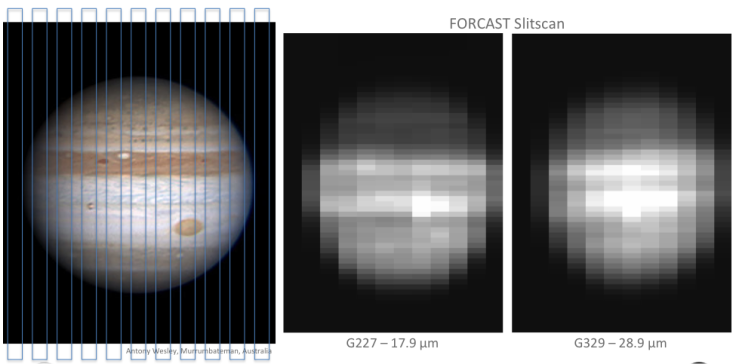Jupiter’s Tumultuous Atmosphere Observed Using NASA’s Airborne Observatory

A team of astronomers has, using NASA’s Stratospheric Observatory for Infrared Astronomy (SOFIA), created far-infrared maps of Jupiter. Until now, such observations were only possible from space-based missions such as Cassini, Voyager, and most recently, Juno.
“These SOFIA observations will fill the gap in the wavelength coverage of current and future space-based observatories and provide spatial and temporal context for them,” Leigh Fletcher from the University of Leicester, England, who led a team of researchers that made these observations, said in a statement released Thursday.
Using infrared light allows scientists to see details that would remain hidden in visible light. In this particular case, for instance, astronomers used the Faint Object infraRed Camera for the SOFIA Telescope (FORCAST) to observe the concentrations of ortho- and para-hydrogen — two isomeric forms of molecular hydrogen — in the gas giant’s thick atmosphere.
Ortho-hydrogen molecules are those in which the spins of the nuclei are in the same direction, while para-hydrogen molecules contain nuclei with opposite spins. Scientists use the fraction of para-hydrogen as an indicator for gasses upwelling from deep within Jupiter’s atmosphere.
“Images from SOFIA reveal several interesting features,” NASA said in the statement. “The cold, red spot in the southern hemisphere indicates an upwelling of gas that is cooling the atmosphere. The belt zone structure near the equator shows that the equator is cold and surrounded by warm belts of sinking gas. The atmospheric heating from Jovian aurora in the northern reaches of the planet indicates the presence of methane and ethane in the stratosphere.”
SOFIA — a joint project of NASA and the German Aerospace Center — is the world’s largest airborne observatory. Its main observational apparatus — a German-built far-infrared telescope with an effective diameter of 100 inches — is carried on board a modified Boeing 747SP jetliner that cruises at an altitude of between 39,000 and 45,000 feet.
SOFIA is operational for several weeks a year from Christchurch, New Zealand, during the Southern Hemisphere’s winter months, when the long nights and absence of infrared-blocking water vapor create prime observing conditions.
© Copyright IBTimes 2024. All rights reserved.






















